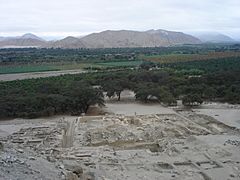Casma River facts for kids
Quick facts for kids Rio Casma |
|
|---|---|

Sechin Complex in the Casma Valley
|
|
|
Location of mouth
|
|
| Country | Peru |
| Region | Ancash Region |
| Physical characteristics | |
| River mouth | Pacific Ocean 9°26′58″S 78°22′57″W / 9.449444°S 78.382375°W |
The Casma River is an important river in Peru. It flows through the northern part of the Casma province in the Ancash Region. Upstream, it's also known as the Río Grande. This river starts high up in the Black Mountain Range. It then flows all the way to the Pacific Ocean. One of its main smaller rivers that joins it is the Sechín River.
The valley around the river is home to the town of Casma. This town was once very important. It had to be rebuilt after a big earthquake in 1970. The new town is now complete.
Contents
What Grows in the Casma Valley?
The main activity in the Casma Valley is agriculture, which means farming. Farmers here grow many different crops.
- Fruits: They grow tasty fruits like avocados, passionfruit, apples, mangoes, pacay (a local fruit), bananas, guayaba, pepino (a sweet fruit), and grapes.
- Other Crops: Farmers also plant corn, cotton, asparagus, chilies, and different kinds of beans.
Ancient History of the Casma Valley
The Casma Valley is a special place for archaeology. It is located about 320 kilometers (200 miles) north of Lima, Peru. The valley lies along the Casma River, between the towns of Chimbote and Huarmey.
Many large and important ancient sites are found here. These sites belong to the Casma/Sechin culture. Some of these amazing places include:
- Stone-faced pyramids: These are huge structures built with stones.
- Thirteen Towers of Chankillo: These ancient towers were likely used to track the sun.
- Sechín Alto: This is one of the largest buildings ever made in the Americas before the year 1000 BCE.
- Cerro Sechin: This site also comes from the ancient Sechin culture.
Huaynuná: An Old Coastal Site
(Coordinates 9°21′00″S 78°25′19″W / 9.35°S 78.422°W)
Archaeologists have also explored a very old site called Huaynuná (Huaynuma). It's on the coast, about 13 kilometers (8 miles) north of the Casma Valley. At Huaynuná, they found an early public building. It was a large structure built on a hillside, likely for religious ceremonies. This building is an early example of the big religious mounds found later along the coast of Peru.
Findings from Huaynuná and other Casma Valley sites show that big-scale farming using irrigation, making pottery, and weaving cloth started around 1600 BCE in this area. This was about 200 years later than similar developments in central Peru.
Interestingly, archaeologists also found potatoes at Huaynuná that date back to about 2000 BCE. This is one of the earliest discoveries of potatoes in all of South America!
See also
 In Spanish: Río Casma para niños
In Spanish: Río Casma para niños


